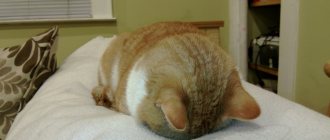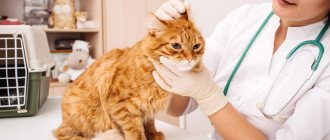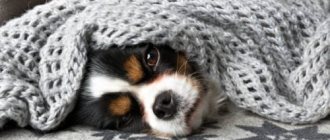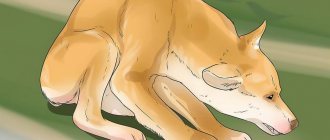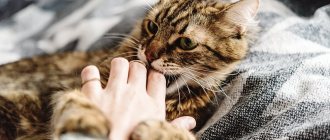People take colds so lightly that when they get sick, they don’t even stop working, infecting healthy people in transport and colleagues at work. In the modern pace of life, it is not customary to take sick leave or reschedule plans. Our pets live differently, but they get sick like us. A cold in cats is not a fatal disease, but it poses a greater danger than the familiar human acute respiratory infection.
Causes of the disease
The disease can occur for a number of reasons, including:
- Improper maintenance of a mustachioed pet. A cat can become hypothermic while outside or on a balcony; catch a cold due to drafts moving around the room; “earn” a runny nose if the hair remains wet after washing.
- Viral infection. Pets can become ill by contracting the disease from sick street animals.
Incorrectly selected food, lack of proper care, and the presence of chronic illnesses weaken the body’s immune system; weakened immunity contributes to the development of colds.
If the owner is confident that the animal is being kept properly and there are symptoms of the disease, then it is necessary to treat the animal for a viral infection.
Veterinarians call the disease “rinotracheitis”, it refers to complex diseases, the causative agent is a virus located in the external environment, found in the urine, feces, and secretions of a sick individual. Can be transmitted through direct contact by airborne droplets.
A cat that doesn't go outside can still become infected. The pathogen can enter the apartment by ending up on the owner’s street shoes or clothes.
Prevention measures
Proper care of your pet can minimize the risk of developing diseases. A balanced diet and compliance with sanitary standards allows you to maintain your cat’s immunity at the proper level.
Pets are sensitive to stress. Therefore, at such moments, plant-based sedatives can be given.
To prevent colds, wrap your cat in a dry towel after washing or being exposed to rain. Drying should take place in a warm room without drafts. If the pet calmly accepts the hair dryer, then the drying process can be accelerated with its help.
In cool and humid weather, you should stop walking outside.
A decrease in immunity can occur due to infection with parasites. Therefore, all animals must be regularly treated with anthelmintics.
In order to reduce the likelihood of rhinotracheitis, vaccination is done. It is carried out once a year at a veterinary clinic. The vaccine is inexpensive and provides good protection.
Feed
For nutrition, cats use food ranging from premium to holistic. They have a balanced composition, which includes not only nutrients, but also essential vitamins and minerals.
If the owner is a follower of natural nutrition, then the cat's diet should consist of raw meat, a small amount of vegetables and vegetable oil. If necessary, additional supplements with minerals and vitamins are given.
Symptoms
The clinical picture of a viral infection and a cold is easy to confuse; the symptoms are almost the same.
Sick beast:
- feels weak, constantly lies down, stops playing;
- loses interest in his surroundings;
- practically stops eating;
- has difficulty breathing;
- begins to cough, sneeze;
- discharge appears from the sinuses;
- lacrimation is observed;
- the nasal mucosa becomes hot and dry;
- body temperature rises.
Be sure to read:
Herpes in cats: symptoms and treatment, modes of transmission, folk remedies and medications
The clinical picture of a viral infection can be complemented by the following signs:
- the lymph nodes located under the jaw increase in size;
- the nasal sinuses become covered with a white coating;
- the cat has difficulty eating and drinking water;
- Ulcers form on the mucous membranes of the lips, tongue, and eyes.
Symptoms of a cold in a cat
The disease affects the eyes, respiratory organs and nasal mucous membranes. Signs of a cold in a cat are as follows:
- Dryness and change in temperature of the nose.
- Signs of body intoxication. The cat becomes weak and lethargic, she refuses food and games. With a mild to moderate cold, the cat easily rises from the bed and stands confidently on its paws. A severe course of the disease is indicated by severe weakness, in which the animal prefers to lie down constantly.
- Runny nose. The fact that the cat has caught a cold is indicated by difficulty breathing and the appearance of clear, thick discharge from the nose. A sick pet breathes through its mouth, which contributes to drying out of the mucous membranes. The animal begins to drink water more often. The cat's mouth is constantly open. If the nasal discharge becomes yellow or greenish in color, it is a sign of a bacterial infection.
- Coughing and sneezing. These signs indicate the launch of protective mechanisms aimed at clearing the respiratory tract of mucus. Coughing and sneezing during a cold is considered normal. In this case, a light coating may appear on the cat’s lip. Severe contamination of fur in the nose and mouth area indicates the presence of more dangerous diseases.
- Inflammation of the mucous membranes of the eyes. Accompanied by photophobia and lacrimation.
- Decreased appetite. The cat may refuse food for several days, while it drinks large amounts of liquid. It is not worth forcing the animal to eat; if the appetite does not return after 3 days, contact a veterinarian.
- Increased body temperature.
The cat has a cold and is sneezing: what to do?
If your pet is sneezing, coughing, the nose is dry and hot, the eyes are watery, there is no appetite, breathing is difficult, you should give the cat first aid.
Algorithm of actions:
- Carry out a visual inspection, analyze whether the disease is the result of a viral infection.
- Place the sick person in a comfortable, warm place, making sure there are no drafts.
- Put a heating pad on if the animal is cold.
- Give plenty of warm water and milk. Cold drinks are prohibited.
- Massage your body to increase blood circulation.
- Offer nutritious food.
If after two or three days the pet’s condition remains unchanged, you must visit a veterinary clinic, where the doctor will make an accurate diagnosis.
Preventive actions: how to keep your pet safe
Treat your pet cats with love and responsibility. If your pet gets wet, be sure to dry its fur immediately. During bathing, the water temperature should not be low (for mustaches, a suitable indicator is over 37 degrees); a separate towel should be provided for the cat. After bathing, wrap your pet in a towel and hold him close. This will allow your pet to warm up and calm down.
Give your cat a separate area. Cover your sleeping area with a warm cloth. Feed your pet only high-quality food, promptly changing the water to fresh water. It is advisable to include vegetables in the diet (prepare special cutlets) to increase resistance to disease.
If the effect of treatment does not occur, be sure to contact your veterinarian. Responsibility for the life of the pet lies entirely with the owner.
How to treat at home
A calm course of the disease requires treatment at home.
A number of activities should be included in therapy:
- Provide coziness and comfort.
- Ease your general condition.
- Relieve symptoms.
- Stop further development of the disease.
Before starting drug therapy, you should monitor the body's reaction; perhaps the animal will recover without medication.
It is useful to include inhalations based on eucalyptus oil and eucalyptus leaves in therapy.
The procedure is carried out as follows:
- Prepare a decoction from the leaves of the plant, place a hot pan indoors (bathroom).
- Wrap the animal in a terry towel so that the cat cannot resist.
- Move your muzzle to the pan with healing steam.
- Make sure that the animal does not get burned.
- Do inhalation for 10-15 minutes, 2 times a day.
The eyes and nasal passages are washed with warm water to relieve the general condition.
How to treat a cat yourself
If the disease progresses calmly, the pet can be treated at home. Therapy involves comprehensive relief of symptoms, alleviation of the general condition and stopping the progression of the infection. Before treating a cold with medication, follow these steps and monitor your pet for 12 to 24 hours. If the condition improves, the animal may be able to cope on its own. If the condition worsens or new symptoms appear, it is necessary to add medications.
- Place the animal in a dry, ventilated area.
- Provide peace.
- Provide your cat with a warm drink, preferably milk.
- If the animal is cold, cover it and make a heating pad.
- Give the animal a massage from the limbs to the body; if the cat does not like such procedures, just pet it - this will increase blood flow and help the body fight.
“Home” symptomatic treatment is allowed at the stage of a runny nose and increased lacrimation; the cat must be helped to clear the airways, for this:
- We clean the nose and eyes of secretions with a moistened cotton sponge. Wet the sponge in clean water; do not use herbal infusions unless you are sure that your pet is not allergic.
- We rinse the nose with the solution, choose one of the options: Adrenaline + novocaine 1%;
- Tannin 0.5%;
- Ethacridine 0.2%;
- Zinc sulfate 2%.
- We instill the nose with a special veterinary medicine or a mixture of fish oil and methanol 1%.
- We try to place streptocide powder in the nostrils, but the cat really doesn’t like it.
Important! If discharge from the eyes and ears becomes purulent, contact the clinic immediately. This is one of the signs of acute pneumonic distemper in cats; the disease is transient and deadly.
If the condition worsens and a cough appears, antibiotics for cats for colds are relevant. If you are not a doctor, it is better to decide what to treat after consulting a doctor. There is no opportunity to go to the clinic - call, but do not make a choice at random, especially do not treat the animal with your own medications.
Important! Do not self-medicate if you are not sure of the diagnosis and do not have experience in keeping and basic treatment of pets.
Treating cat colds with medications
Treatment of the animal is carried out at home, after consulting with a veterinarian. It is difficult to give medications in tablet form to cats because of the bitter taste.
It is forbidden to give antipyretic drugs (aspirin, paracetamol) to cats due to the toxic effects on the animal’s body.
To reduce the temperature, use a cool, damp compress, which is placed on the animal’s head.
Be sure to read:
Panleukopenia in adult cats and kittens: the first signs of the disease, how to treat and what to do.
Abundant liquid discharge from the nasal sinuses is stopped with the help of nasal drops, which are prescribed to a person. A runny nose can be relieved by Nazivin and Xylometazoline. 1 drop in each nasal passage 2 times a day.
Only a veterinarian can prescribe antibacterial agents (antibiotics); the doctor will recommend the drug and determine the dose.
A sick cat is prescribed drugs of the tetracycline group. The medication is taken 2 times a day.
Drugs for treatment:
- "Ampicillin"
- "Streptomycin",
- "Tetracycline"
- "Amoxicillin"
- "clindamycin"
When treating colds, Interferon and Immunoglobulin are used in injections.
To strengthen the immune system, injections of B vitamins are recommended.
Predisposing factors, routes of transmission
- The more crowded conditions animals are kept in, the faster the infection spreads among them. If you have come across kittens that were previously kept in shelter conditions, then you probably know that almost every second animal can cough and sneeze. Unsanitary conditions and “wandering” bowls for water and food from enclosure to enclosure greatly contribute to the rapid transmission of infection. Stress also plays an important role, since stress factors very significantly reduce the natural resistance of the animal body. In addition, cats after surgery are extremely susceptible to colds, since their bodies need time and rest to fully recover from the consequences of surgery.
- Note that even animals that have recovered from the disease can be carriers of the disease , and the period of carriage varies greatly from several weeks to months. Therefore, I would like to advise owners of recovered pets to prevent contact of such animals with their healthy relatives.
- Hypothermia is the main trigger for such diseases. Short-haired animals and, in particular, sphinxes, which have no hair on their body, are especially predisposed to it.
Possible consequences of a cold
It can be difficult for cat owners to understand that the disease is not typical for a small predator, and the complications, if left untreated, are extremely dangerous. A cat's illness rarely poses a danger to the human body, but can be transmitted to other four-legged and feathered inhabitants of the apartment.
If you ignore the primary symptoms and do not start treatment in time, the disease progresses to a serious stage.
Typical complications:
- bronchitis,
- pneumonia,
- joint damage,
- genitourinary infections.
Also, the immune system weakened by the disease is a poor “protector” for the animal. Viruses brought by the owner on street clothes and shoes can easily infect a sick body.
General information: what causes the disease
A pet's health may be compromised for a variety of reasons. Cats, like people, react acutely to cold weather. Decreased immunity in a pet is a provoking factor for the penetration of viruses and infection with colds.
List of possible reasons:
- hypothermia – long cat walks at low temperatures, in the rain or wind;
- unbalanced diet, lack of vitamins or a consequence of changing the usual food;
- age – older cats with other chronic diseases are especially susceptible to colds;
- improper living conditions (damp room, drafts).
Note! A harbinger of a cold in all warm-blooded animals is the presence of a compensatory reaction. The longer the exposure to cold on the body, the stronger the health problems will manifest in the future.
Prognosis of the course or what the disease leads to
Many owners think that a cat’s cold is a common mild illness that the pet can survive on its own. But lack of treatment can lead to irreversible consequences: inflammation, kidney and joint diseases develop. Among the pathological results of a cold are an acute decrease in immunity and a high susceptibility to other infectious agents.
Main symptoms
Colds in cats are easily diagnosed. A sick animal does not behave actively. Symptoms such as:
- decreased appetite or excessive desire to eat;
- refusal of water;
- the occurrence of problems with the coat (the fur may fall out in clumps, which provokes the appearance of bald patches; against the background of such an imbalance, dermatitis and skin ulcers occur);
- the presence of purulent or cloudy discharge from the eyes and nose;
- increase or sharp decrease in temperature;
- the appearance of vomiting;
- problems with stool;
- bloody discharge in urine or feces;
- difficulty urinating.
Can a cat catch a cold from a person? It has not yet been proven 100%

